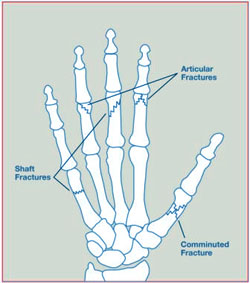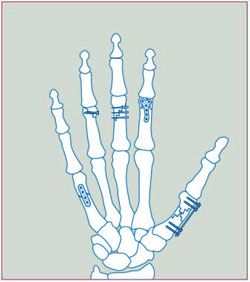 A broken bone results in pain, swelling and difficulty using the affected part. Many people don’t know this, but a bone fracture is the same as a break.
A broken bone results in pain, swelling and difficulty using the affected part. Many people don’t know this, but a bone fracture is the same as a break.
What is it?
As you may know, the hand is made up of many, small bones that create a supporting framework. The frame provides a point of attachment for the various muscles that control wrist and finger movement. A broken bone results in pain, swelling and difficulty using the affected part. Many people don’t know this, but a bone fracture is the same as a break. Some fractures are simple, and though the bone is broken, it is still aligned. More serious breaks result in the bone pieces becoming unaligned. A comminuted fracture causes the bones to shatter into many pieces and is often the result of a strong force. An open (or compound) fracture happens when a bone fragment comes through the skin, which causes a risk of infection.
What causes it?
When enough force is applied to the hand’s delicate bones, a fracture will occur. This force can be caused by many outside forces as well as an accidental fall.
 What are the symptoms?
What are the symptoms?
There is usually pain, swelling, or stiffness in the body part. It is also often very difficult for the patient to move the injured part.
How do we diagnose it?
The physician must observe the injury and conduct a physical exam. In addition, you should be prepared to provide your medical history, as well as information on how the injury occurred.
How is it treated?
A medical exam and x-ray are often required for your doctor to be able to tell if a fracture has occurred, and to determine the best course of treatment.
Depending on your specific case, one of the following treatments may be recommended:
- Splint/Case – A fracture that’s not displaced can be treated with a splint or cast, which protects a break that has been set. Some fracture sets need to be held in place with wires or pins which do not require an incision.
- Surgery – Some fractures might require surgery in order to be properly set surgically with internal pins, plates or screws. Occasionally, a bone might be missing or so severely damanged that it can’t be repaired. In that case, we use a bone graft from another part of the body to lend stability.
- External Fixator – Metal bars that are attached to pins outside of the body can be utilized until the bone heals.
- When the fracture regains some stability, therapeutic exercises should be employed to make sure that stiffness doesn’t set in. We will determine when the bone is ready for limited movement.
In treatment, the bone doesn’t need to be perfectly aligned necessarily to regain function. Challenges with healing include stiffness, position shift, and infection. It has been shown that smoking may slow bone healing.


